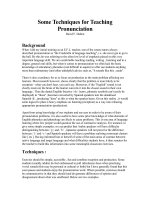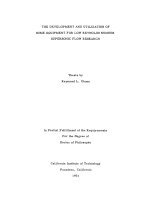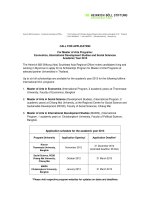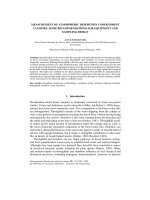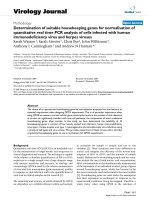CHECK OUT OUR WEBSITE SOME TIME FOR PLENTY OF ARTICES ABOUT SELF DEFENSE, SURVIVAL, FIREARMS AND MILITARY MANUALS. pot
Bạn đang xem bản rút gọn của tài liệu. Xem và tải ngay bản đầy đủ của tài liệu tại đây (4.48 MB, 309 trang )
CHECK OUT OUR WEBSITE SOME TIME FOR PLENTY OF ARTICES ABOUT SELF DEFENSE,
SURVIVAL, FIREARMS AND MILITARY MANUALS.
Thank you for purchasing our ebook package.
Introduction to Radio Equipment
Folks,
Introduction to Radio Equipment, NAVPERS 10172, 1946 was created just after WW II. It is a basic
introduction to tube era elections and has specifics on typical radios at the end.
In this online version of the manual we have attempted to keep the flavor of the original layout while
taking advantage of the Web's universal accessibility. Different browsers and fonts will cause the text to
move, but the text will remain roughly where it is in the original manual. In addition to errors we have
attempted to preserve from the original this text was captured by optical character recognition. This
process creates errors that are compounded while encoding for the Web.
Please report any typos, or particularly annoying layout issues to
for correction.
Richard Pekelney
Webmaster
Search Introduction to Radio Equipment
(1 of 5)5/2/2006 16:41:36
Introduction to Radio Equipment
INTRODUCTION TO
RADIO EQUIPMENT
PREPARED BY
STANDARDS AND CURRICULUM DIVISION
TRAINING
BUREAU OF NAVAL PERSONNEL
NAVY TRAINING COURSES
EDITION OF 1946
UNITED STATES
GOVERNMENT PRINTING OFFICE
WASHINGTON: 1946
(2 of 5)5/2/2006 16:41:36
Introduction to Radio Equipment
This page blank
PREFACE
This is one of a series of Training Manuals written to aid the RADIOMAN in performing his duties. The
first 20 chapters contain a brief discussion of basic electricity, the principles of vacuum tubes, receivers
and transmitters. Chapter 21 will be of special interest to all personnel of the radio communication rates,
since it contains the latest information on radio wave propagation. It will prove particularly valuable in
selecting the correct frequency for a transmission. The last two chapters contain brief descriptions and
directions for operation of Navy transmitters and receivers most frequently used.
This manual should be issued to the radioman striker and be used by all rates until its usefulness has been
exhausted. It must be understood that successful completion of this text is not a requirement for any rate.
The specific sections that may be required for advancement must be in accordance with Part D of the
Bureau of Personnel Manual.
No attempt has been made to include the large volume of subject matter necessary for servicing and repair
of radio equipment. Where maintenance duties are required of a RADIOMAN, the Training Courses
written for the Electronics Technician's Mates should be issued.
As one of the NAVY TRAINING COURSES, this book represents the joint endeavor of the Training
Courses Section of the Bureau of Naval Personnel and those sections of Chief of Naval Operations
especially cognizant of Naval Communication Training.
III
TABLE OF CONTENTS
Preface
iii
CHAPTER 1
What is electricity?
1
CHAPTER 2
Batteries
17
CHAPTER 3
Circuits
25
CHAPTER 4
Ohm's Law
33
CHAPTER 5
Magnetism
41
(3 of 5)5/2/2006 16:41:36
Introduction to Radio Equipment
CHAPTER 6
Electromagnetism
53
CHAPTER 7
Generators
65
CHAPTER 8
Motors
79
CHAPTER 9
More about induction
87
CHAPTER 10
The condenser
103
CHAPTER 11
Resonance
113
V
TABLE OF CONTENTS (Continued)
CHAPTER 12
The vacuum tube
119
CHAPTER 13
Amplifier tubes
127
CHAPTER 14
More amplifier tubes
139
CHAPTER 15
Jobs of a vacuum tube
149
CHAPTER 16
Background to modern radio
157
CHAPTER 17
Introduction to transmitters
163
CHAPTER 18
Introduction to receivers
171
CHAPTER 19
Remote control system
189
CHAPTER 20
(4 of 5)5/2/2006 16:41:36
Introduction to Radio Equipment
The antenna 201
CHAPTER 21
Wave propagation
215
CHAPTER 22
Navy transmitters
237
CHAPTER 23
Navy receivers
307
Quiz
341
Index
361
VI
Next Chapter
Copyright (C) 2005
Historic Naval Ships Association
All Rights Reserved
Legal Notices and Privacy Policy
Version 1.00, 12 Nov 05
(5 of 5)5/2/2006 16:41:36
Search Introduction to Radio Equipment
Search Introduction to Radio Equipment
Match: Format: Sort by:
Search:
Return to the
Historic Naval Ships Association home page.
All Rights Reserved.
Legal Notices and Privacy Policy
Version 1.00, 2 Nov 05
16:41:36
All
Long
Score
Search
Introduction to Radio Equipment - Chapter 1
INTRODUCTION TO RADIO
EQUIPMENT
CHAPTER 1
WHAT IS ELECTRICITY?
MEET THE ATOM
A single atomic bomb demonstrated to a startled world that the ATOM is a source of a lot of energy.
Since then the atom has been pictured as a new and untapped source of power.
Actually, it is neither new nor untapped. For years, man has known the atom to be composed of
POSITIVE and NEGATIVE charges of electricity-that these charges have been used to turn the wheels of
industry, power our trains, and energize our radio transmitters.
The story of how your transmitter sends a message begins with the atom itself. The ACTIVITY of the tiny
negative and positive charges within the atom is the source of energy that sends your radio message to
Singapore or Saipan.
YOU KNOW SOMETHING ABOUT IT
You have experimented with atomic energy man. times. Remember the fun you had rubbing your shoes
on the rug and then giving an electric shock to another person by bringing your finger near the end of his
nose? And
1
(1 of 15)5/2/2006 16:41:39
Introduction to Radio Equipment - Chapter 1
you probably have heard the snap and crack of electric sparks, as you stroked a cat's back. These little
demonstrations were experiments with the positive and negative charges of the atom.
WHAT IS THE ATOM LIKE?
There are ninety-odd known kinds of atoms, ranging from simple hydrogen with ONE POSITIVE and
ONE NEGATIVE charge to the famous uranium atom with many charges.
All atoms, whether simple or complex, have a similar basic arrangement. They have a concentration of
material in a central mass called the NUCLEUS and a number of NEGATIVE charges revolving in
ORBITS about the nucleus.
HYDROGEN ATOM
The structure of three single atoms-hydrogen, helium, and lithium-is given in figure 1. Hydrogen has
ONE
Figure 1 Hydrogen, helium, and lithium atoms.
positive charge (PROTON) and ONE negative charge (ELECTRON). The PROTON is in the NUCLEUS,
and the ELECTRON is floating about the nucleus in an ORBIT, like the moon revolving about the earth.
The second atom, HELIUM, has four protons and four electrons. ALL of the PROTONS and TWO of the
ELECTRONS are in the nucleus, and the other two electrons are in the orbit.
The third element, LITHIUM, has seven electrons and seven protons. ALL of the PROTONS and FOUR
of the
2
ELECTRONS are in the nucleus, and the remaining three electrons are in the orbits. Also notice that with
lithium, a SECOND ORBIT is added.
(2 of 15)5/2/2006 16:41:39
Introduction to Radio Equipment - Chapter 1
Figure 2 Atoms of oxygen, neon, and sodium.
The atoms of oxygen, neon, and sodium, in figure 2, continue to show a systematic arrangement of
electrons and protons. The atoms given so far show these facts-
ALL the PROTONS and approximately one-half of the ELECTRONS are in the nucleus, and the
REMAINDER of the ELECTRONS are in the orbits. Each orbit has a maximum number of electrons that
it can hold-for instance, TWO on the first, and EIGHT on the second.
THE NEUTRON
Of the six atoms so far described, NEUTRONS (N) are present in each atom except hydrogen. Don't be
alarmed. The neutron is just one ELECTRON COMBINED with one PROTON to form one NEUTRAL
CHARGE (NEUTRON)-
1 electron + 1 proton = 1 neutron.
Neutrons are dead ducks so far as electricity is concerned, so don't let them trouble you.
Turn to figure 2 again. The helium nucleus contains four protons and two electrons. The two electrons
combine with two of the protons to form TWO NEUTRONS. This leaves an excess of two PROTONS,
which give the nucleus TWO POSITIVE CHARGES.
Helium has TWO ELECTRONS in the first orbit. Therefore, an atom of helium is balanced, since it has
TWO
3
(3 of 15)5/2/2006 16:41:39
Introduction to Radio Equipment - Chapter 1
POSITIVE CHARGES in the nucleus and TWO NEGATIVE charges in the orbit.
How about lithium ? It has four neutrons, three positive charges, and three negative charges. You can see
that it is also a BALANCED atom. Similarly, oxygen, with eight neutrons, eight positive charges, and
eight negative charges, is a balanced atom.
In each case an atom as an individual unit is a BALANCED, UNCHARGED piece of matter.
THEORY OF BUILDING A CHARGE
From the information given so far, it appears that all atoms have a balance of charges. That is true until
you do something to destroy the balance.
Most atoms are eccentric things. Some have a tendency to GIVE AWAY ELECTRONS; others have a
tendency to BORROW or STEAL ELECTRONS from other atoms.
Figure 3 How an atom becomes positively charged.
Lithium in figure 3 is an element that tends to GIVE AWAY one of its electrons. When it does this, the
remaining charge will be-
2 electrons
with -leaving a net charge of 1 proton
3 protons
So by giving AWAY AN ELECTRON, lithium becomes positively charged.
4
(4 of 15)5/2/2006 16:41:39
Introduction to Radio Equipment - Chapter 1
Figure 4 shows how an atom of chlorine becomes negatively charged. It borrows an electron from some
other atom to form-
8 protons
with -leaving a net charge of 1 electron
9 electrons
In each case it is the ELECTRON that DOES THE MOVING. BY GIVING ELECTRONS AWAY a
POSITIVE CHARGE is produced;
Figure 4 How an atom of chlorine becomes negatively charged.
BORROWING ELECTRONS produces a NEGATIVE CHARGE. Remember those statements. They are
THE BASIS OF ELECTRICITY.
But why doesn't the proton move? In some cases it does, but since the proton is about 2,000 times heavier
than the electron, the proton will move only when great force is applied. It is like moving an aircraft
carrier as compared with moving a whale boat.
With the exception of lithium, the atoms so far discussed are normally gases. Don't let that trouble you-at
high enough temperatures lithium too becomes a gas. The same holds for all other atoms.
You now know the theory of producing a charge, and you're ready for some practical examples.
HOW YOU CHARGE AN OBJECT
Go back to the old trick of rubbing your shoes on the rug. The FRICTION between the sole of your shoe
and
5
(5 of 15)5/2/2006 16:41:39
Introduction to Radio Equipment - Chapter 1
the rug removed some electrons from the leather, leaving a POSITIVE charge. Then, when you touched
your finger to another fellow's nose, ELECTRONS jumped between your finger and his nose.
That little track of giving somebody an electric shock brings up some important questions-
How did the charge get from the shoe to your finger?
Why did the spark jump?
What was the spark?
The answer to the first question-the electric charge did not remain concentrated in one spot but distributed
itself evenly over your whole body.
Why did the spark jump? Nature does not like INEQUALITIES. Since the other person's body had a
different number of electrons than yours, some electrons moved from one body to the other to
EQUALIZE the number of electrons on both.
HERE IS A LAW which applies to those first two questions-
"Nature always attempts to distribute EQUALLY the number of ELECTRONS on all objects, with the
EXCESS electrons MOVING to areas where they are FEWER in number."
Now, what was the spark? A stream of electrons.
CREATING A CHARGE-ADDING OR SUBTRACTING ELECTRONS
When you create a charge-by stroking a cat's back, by combing your hair, or by running a leather belt over
a pulley-the charge is produced by FRICTION REMOVING ELECTRONS from one object and
ADDING them to the other. The object that LOSES electrons becomes positive ; the one that gains
electrons becomes negative.
LIKES REPEL, UNLIKES ATTRACT
The law of LIKES and UNLIKES needs little introduction. You've seen it in operation when a charged
comb picks up bits of paper.
6
In figure 5, two negatively charged and two positively charged balls are placed near each other, and with
each LIKE charge a force of repulsion exists.
(6 of 15)5/2/2006 16:41:39
Introduction to Radio Equipment - Chapter 1
Figure 5 Likes repel, unlikes attract.
Now if one ball is given a positive charge and the others a negative, as illustrated in figure 6, a force of
attraction will exist.
Figure 6 Unlikes attract.
Since the positive charge is 2,000 times heavier than the negative, the positive will REMAIN almost
FIXED while the negative charge is FREE TO MOVE. It is said, "the ELECTRON is attracted to the
POSITIVE charge."
7
(7 of 15)5/2/2006 16:41:39
Introduction to Radio Equipment - Chapter 1
STATIC ELECTRICITY
The electrical charges that appear on your shoes, a comb, or a cat's back, are called STATIC, because they
are standing still.
Surrounding the charges is an area that is influenced by the charges. This area is called the
ELECTROSTATIC field. The stronger the charge, the stronger the field. If the charge is increasing in
strength, the field is expanding. A decreasing charge will produce a contracting field.
Electrostatic fields are important in radio circuits. In some places you want them, in others you do not.
Look inside any receiver or transmitter, and you will see metal walls or cans isolating certain coils,
vacuum tubes and condensers from other elements in the circuit. These SHIELDS keep the electrostatic
fields confined to the places where they are wanted, and away from areas where they can cause trouble.
CURRENT ELECTRICITY-MOVING ELECTRONS
When electrons of a static charge MOVE, it is no longer STATIC electricity, but CURRENT electricity.
Think back to the electric spark again. The spark that jumped between your finger and some other object
was a STREAM of electrons.
Certainly you have noticed that some sparks are large and others are small. More electrons are flowing in
a large spark than in a small one. It's like comparing rivers of different size. The flow of a river is
measured in units of gallons or cubic feet that pass a point each minute. The flow of electricity is
measured by the NUMBER of ELECTRONS that pass a point each SECOND.
UNIT OF ELECTRICITY-COULOMB
No one has ever seen an electron or probably ever will ; so to simplify the job of counting them,
individual electrons are grouped together into a large unit. It's like grouping grains of sugar into a large
unit, the pound.
8
(8 of 15)5/2/2006 16:41:39
Introduction to Radio Equipment - Chapter 1
You probably never troubled to count the grains in a pound of sugar, but some one did CALCULATE the
NUMBER of electrons in the UNIT of electricity, the COULOMB. He found that it contained 6.3 billion
billion ELECTRONS. That number is 63 with 17 zeroes after it. And that is a lot of electrons.
RATE OF FLOW-AMPERE
The name given to the unit of electrons is the coulomb. Now when ONE COULOMB of electricity passes
a point in a SINGLE SECOND, ONE AMPERE of electricity is flowing. Thus an AMPERE is to
ELECTRICAL FLOW as the GALLON-PER-MINUTE is to WATER FLOW. It is the RATE of FLOW.
One-half coulomb per second is ½ ampere; 1/1000 coulomb is 1/1000 ampere or one milliampere,
abbreviated (ma.).
In radio work, the most-used unit of current is the MILLIAMPERE. With receiving circuits, the range is
from one or two to about 50 milliamperes, while with transmitters, the current flow will range upwards of
SEVERAL HUNDRED milliamperes.
THE VOLT
Volume of CURRENT is not always the same. It varies directly with the size of the charge. Since work is
required to move electrons and create a charge, the size of charge may be expressed in units of WORK
DONE to move the charge.
The VOLT is the unit used to express the amount of work done to create a charge. One VOLT of charge is
created when one JOULE of work is done in moving a COULOMB.
A volt actually expresses more than degree of charge. When you pile up a surplus of electrons, you are
creating a RESERVE OF ENERGY. ENERGY IN RESERVE IS POTENTIAL ENERGY. Thus a volt
may also be used as an expression of the potential energy of an object.
699198°-46-2
9
(9 of 15)5/2/2006 16:41:39
Introduction to Radio Equipment - Chapter 1
VOLTAGES ARE DIFFERENCES IN POTENTIALS
Since no object is of zero potential, and it is possible to create a charge by either adding or removing
electrons, the energy of two points is not expressed in ACTUAL potentials but in DIFFERENCES of
potential.
So when you say an object has a potential of 200 volts, all you are actually stating is the DIFFERENCE in
the potentials of two points.
Since all objects have some potential, it is a common practice to designate some point as ZERO potential.
In a radio, zero potential is usually the frame or chassis of the set. Hence, when you say the plate of a
vacuum tube is positive 200 volts, you are only stating that the plate is 200 volts more positive than the
chassis.
The rate of current flow is influenced by the magnitude of the difference between the two charges. If the
difference between the charges is small, the rate of flow will be low, but if the difference is large, the rate
of flow will be large.
THERE ARE NEGATIVE POTENTIALS ALSO
Although the chassis of a radio is given as "zero" potential, it is possible for CERTAIN PARTS of a
receiver or transmitter to be at a lower potential than the chassis. All these parts are said to have
NEGATIVE potentials.
You will find the GRIDS of vacuum tubes stated as being -5, -10, or -50 volts. It means that the grids of
those tubes are at a LOWER positive potential than the chassis, by 5, 10, or 50 volts.
Don't let a NEGATIVE potential fool you. There is just as much "wallop" between -200 volts and the
chassis as between +200 volts and the chassis.
ALL VOLTAGES ARE ONLY RELATIVE
Now you are beginning to get the whole picture. Voltage is only a RELATIVE THING. Look at figure 7.
Point A is given as being -200 volts in comparison to the chassis. And B is 200 volts more positive than
the
10
chassis. Hence you may say, point B is 400 volts more POSITIVE than A. Turn things around-point A is
400 volts NEGATIVE in respect to B.
(10 of 15)5/2/2006 16:41:39
Introduction to Radio Equipment - Chapter 1
Figure 7 Relative potentials.
How about point C? It is 100 volts positive in respect to the chassis, but 100 volts more NEGATIVE than
point B. So in respect to A, C is 300 volts positive.
Now point D. It is 50 volts NEGATIVE in RESPECT to the CHASSIS but 150 volts positive in respect to
A. Thus point D is also 150 volts more negative than C, and 250 volts more negative than B.
So you see all potentials (voltages) are ONLY RELATIVE THINGS. When you state the voltage of an
element, remember that what you state is true ONLY in RESPECT TO ANOTHER POINT.
ELECTRONS FLOW TOWARD THE MORE POSITIVE
Here is a little statement to remember. "Electrons flow toward the MORE positive potential." Even if all
potentials are given as negative, the electrons move from the MOST negative toward the LEAST negative
potential.
Figure 8 Direction of electron flow.
It may look in figure 8 as if electrons are flowing up hill. Well, maybe so, but that shouldn't trouble you.
You have seen other things pulled upwards, for instance, a magnet picking up a pin or nail. To place your
mind
11
at ease, just think of elections being PULLED TOWARD the MORE POSITIVE POTENTIAL.
The HIGHER the VOLTAGE-the greater the potential difference-the greater the flow of electrons.
RESISTANCE-OPPOSITION TO FLOW OF ELECTRONS
Thus far, only the voltage has been given as a factor influencing the rate of flow of electrons. But
OBSTACLES in the path of the electrons have a great effect on electron movement.
Electrical obstacles are called RESISTANCES. All materials have resistance. In the case of most metals,
the resistance is low. But with some substances, such as glass, rubber, and cotton, the resistance is great
enough to stop the flow completely.
CONDUCTORS AND INSULATORS
(11 of 15)5/2/2006 16:41:39
Introduction to Radio Equipment - Chapter 1
The amount of resistance offered by a material depends upon the NUMBER OF FREE ELECTRONS in
the substance. As an example, COPPER and SILVER have many free electrons, and offer a low
resistance. These metals are called good CONDUCTORS.
Substances like GLASS and RUBBER with few FREE ELECTRONS have high resistance and are called
INSULATORS.
Not all metals conduct current with equal ease. Some offer considerably more resistance than others. The
table below shows six conductors arranged in order, with silver the best and iron the poorest. The
insulators in the right hand column are not arranged in order.
CONDUCTORS
Silver
Copper
Aluminum
Brass
Zinc
Iron
INSULATORS
Dry air
Glass
Mica
Rubber
Asbestos
Bakelite
12
In addition to the KIND of conductors, three other factors-SIZE, LENGTH, and TEMPERATURE-also
affect the resistance of a wire.
The larger the wire is in cross section, the lower its resistance. A long wire naturally has more resistance
than a short one, and with most metals the resistance rises as the temperature of the wire goes up.
UNIT OF RESISTANCE
The unit of resistance is the OHM, which is usually stated in a roundabout manner. An ohm is defined as
Figure 9 Schematic symbol for a fixed resistor.
the amount of opposition that will permit one ampere of current to flow in a circuit with an applied
potential of one volt.
Figure 9 shows the schematic symbol for a resistance as used in radio circuits. More will be given about it
in chapter 3.
(12 of 15)5/2/2006 16:41:39
Introduction to Radio Equipment - Chapter 1
Figure 10 Carbon resistors.
RESISTORS USED IN RADIO CIRCUITS
Radio circuits use a great variety of resistors. Some are simple and small, like the CARBON types given
in figure
13
10 ; others are more complicated, like the tapped, wirewound varieties of figure 11.
Figure 11 Wire-wound resistors.
The carbon resistors are made by fusing and burning a mixture of carbon and clay. The amount of
resistance is determined by the relative mixtures used.
Wire-wound resistors are formed by winding high resistance wire on a ceramic tube. The specific
resistance of the wire and the length of the winding determine the resistance.
With the exception of a narrow strip down one side, the whole resistor is covered with a coat of enamel.
The exposed strip of bare wire is made to permit you to TAP the resistor and obtain the desired resistance.
(13 of 15)5/2/2006 16:41:39
Introduction to Radio Equipment - Chapter 1
Figure 12 Variable resistor.
The resistor in figure 12 is of the VARIABLE type. It is made by wrapping high resistance wire about a
short section of a paper tube. The arm is movable, and by
14
turning the knob, this arm is made to tap-off any value between zero and the maximum resistance.
Figure 13 Variable resistors.
Other forms of variable resistors are given in figure 13. When you turn up the volume on your radio
receiver, it is one of these resistors you are adjusting.
15
Radio Home
Page
Next Chapter
(14 of 15)5/2/2006 16:41:39
Introduction to Radio Equipment - Chapter 1
Copyright (C) 2005
Historic Naval Ships Association
All Rights Reserved
Legal Notices and Privacy Policy
Version 1.00, 12 Nov 05
(15 of 15)5/2/2006 16:41:39
Introduction to Radio Equipment - Chapter 2
CHAPTER 2
BATTERIES
ELECTROMOTIVE FORCE
ALL FORCES that tend to keep electrons moving through a conductor are called ELECTROMOTIVE
FORCES. That should not be difficult to remember if you think of it as ELECTRON-MOVING-FORCE,
or just EMF.
PRIMARY CELL
BATTERIES, or CELLS, as single units of a battery are called, are extremely common. If you have silver
and gold fillings in your teeth, you are carrying a simple cell in your mouth.
Why ? A SIMPLE CELL is formed whenever you have TWO DIFFERENT METALS in an
ELECTROLYTE.
GOLD is one metal; SILVER is another; and SALIVA is an electrolyte. An electrolyte is any liquid, such
as an acid, saltwater or an alkali, that will CONDUCT ELECTRICITY.
A simple cell, sometimes called a primary cell, will continue to deliver current until ONE OF THE
METALS has been EATEN AWAY, or until the ELECTROLYTE IS EVAPORATED.
17
(1 of 8)5/2/2006 16:41:41
Introduction to Radio Equipment - Chapter 2
The cell, once dead, CANNOT BE RECHARGED. The only way to bring it back to life is to put in new
plates and replace the electrolyte.
HOW A PRIMARY CELL WORKS
Most metals have a tendency to give away ELECTRONS and become POSITIVELY charged. Some
metals, like copper and silver, have a much stronger tendency to give away their electrons than do zinc
and iron. Therefore if you place a strip of COPPER and another of ZINC in an electrolyte such as
ammonium chloride (see figure 14),
Figure 14 A simple cell.
the COPPER will give up electrons and become MORE positive. In the external circuit, electrons will
flow away from the zinc, through the resistor, and onto the copper plate.
The chemical action going on inside the cells is too complicated for a discussion at this time, but here is
just a hint of what happens. The ammonium chloride breaks into positively and negatively charged
particles called
18
(2 of 8)5/2/2006 16:41:41
Introduction to Radio Equipment - Chapter 2
IONS. These IONS act as FERRY BOATS to carry the electrons from the copper plate to the zinc plate. It
is this CHEMICAL ACTION that produces the emf.
The COMBINATIONS of metal used play a big part in the action of the cell. The 10 metals and carbon
given below are arranged in order, with gold, the most positive, on top.
Gold
Carbon (not a metal)
Mercury
Silver
Copper
Lead
Tin
Nickel
Iron
Zinc
Aluminum
The second most positive is carbon, next mercury, and so on down the list. In short any metal will be
POSITIVE to any metal that appears BELOW IT. Now, imagine any two metals in a simple cell and
connected by an external circuit. Electrons will flow through the external circuit FROM THE LOWER
METAL TO THE HIGHER METAL.
The FARTHER APART the two metals appear in the table, the larger will be the difference in their
potential. If gold and aluminum are used, the emf will be 2.69 volts. With carbon and zinc, the emf will be
1.8 volts; while with copper and zinc it is only 1.1 volts.
The output voltage of a cell will never be as great as the two metals used indicate, because the
INTERNAL RESISTANCE of the CELL (electrolyte) SUBTRACTS from the potential difference of the
plates. As an example, the actual emf of a carbon-zinc cell is only about 1.5 volts instead of 1.8 volts.
DRY CELL
While primary cells can be used with a liquid electrolyte, it is a common practice to mix the electrolyte
19
with a POWDER, usually manganese-dioxide, to form a paste. The result is a common DRY CELL.
The paste is placed inside a ZINC can, and a CARBON rod inserted into the paste as illustrated in figure
15.
(3 of 8)5/2/2006 16:41:41
